Integrating Knowledge-Based and Machine Learning for Betel Palm Mapping on Hainan Island Using Sentinel-1/2 and Google Earth Engine
Abstract
1. Introduction
2. Results
2.1. Comparison of Different Forest Maps
2.2. Delineating Key Features for Mapping Betel Palms
2.3. Accuracy Assessment and Geographical Characteristics of Betel Palms
3. Discussion
3.1. Mapping Algorithm for Forest
3.2. The Contribution of Optimal Variable Selection for Mapping Betel Palms
3.3. The Advantages of Incorporating Optical and SAR Data for Mapping Betel Palms
3.4. Uncertainties and Future Directions
4. Materials and Methods
4.1. Study Area
4.2. Datasets and Processing
4.2.1. Satellite Data
4.2.2. Forest Dataset
4.2.3. Sample Data
4.3. Mapping Algorithms
4.3.1. Feature Selection from Sentinel-1
4.3.2. Feature Selection from Sentinel-2
4.3.3. Feature Optimization
4.3.4. Knowledge-Based Forest Mapping
4.4. Machine Learning Classifier
4.5. Post Classification
4.6. Accuracy Evaluation
5. Conclusions
Author Contributions
Funding
Acknowledgments
Conflicts of Interest
Abbreviations
| CLCD | China Land Cover Dataset |
| NGCC | National Geomatics Center of China |
| GEE | Google Earth Engine |
| LR | logistic regression |
| GNDVI | Green Normalized Difference Vegetation Index |
| GDP | Gross Domestic Product |
| SAR | Synthetic Aperture Radar |
| ML | Machine Learning |
| RF | Random Forest |
| SVM | Support Vector Machines |
| GBDT | Gradient Boosting Decision Trees |
| VH | vcross-polarized, vertical transmitter, horizontal receiver backscatter |
| VV | vertically polarized backscatter |
| GRD | Ground Range Data |
| AVE | Average |
| DIF | Difference |
| RAT1 | Ratio1 |
| RAT2 | Ratio2 |
| NDI | Normalized Difference Index |
| NL | NL Index |
| GLCM | Gray level Co-occurence Matrix |
| EVI | Enhanced Vegetation Index |
| NDVI | Normalized Difference Vegetation Index |
| Soil-Adjusted Total Vegetation Index | |
| RSEI | Red-edge Spectral Index |
| NDTI | Normalized Difference Tillage Index |
| NDMI | Normalized Difference Moisture Index |
| NDRE | Normalized Difference RE1 |
| GCVI | Green Chlorophyll Vegetation Index |
| MODCRC | Modified Crop Residue Cover |
| STI | Simple Tillage Index |
| MNDWI | Modified normalized difference water index |
| NDNS1 | Normalized Difference NIR and SWIR1 index |
| NDNS2 | Normalized Difference NIR and SWIR2 index |
| GI | Greenness Index |
| VIgreen | Green Vegetation Index |
| SRI | Simple Ratio Index |
| Modified Simple Ratio | |
| MCARI | Modified Chlorophyll Absorption in Reflectance Index |
| TVI | Triangular Vegetation Index |
| TCARI | Transformed Chlorophyll Absorption in Reflectance Index |
| MTCI | Medium resolution imaging spectrometer terrestrial chlorophyll index |
| CIRE | Chlorophyll Index Red Edge |
| CIG | Chlorophyll Index Green |
| OA | Overall Accuracy |
| UA | User’s Accuracy |
| PA | Producer’s Accuracy |
References
- Das, M.; Nath, P.-C.; Sileshi, G.-W.; Pandey, R.; Nath, A.J.; Das, A.K. Biomass models for estimating carbon storage in Areca palm plantations. Environ. Sustain. Indic. 2021, 10, 100115. [Google Scholar] [CrossRef]
- Xu, D.; Lu, Y.W.; Liang, H.; Lu, Z.; Yu, L.J.; Liu, Q. Areca Yellow Leaf Disease Severity Monitoring Using UAV-Based Multispectral and Thermal Infrared Imagery. Remote Sens. 2023, 15, 3114. [Google Scholar] [CrossRef]
- Li, J.; Cao, X.-M.; Jia, X.-C.; Liu, L.-Y.; Cao, H.-W.; Qin, W.-Q.; Li, M. Iron Deficiency leads to chlorosis through impacting chlorophyll synthesis and nitrogen metabolism in Areca catechu L. Front. Plant Sci. 2021, 12, 710093. [Google Scholar] [CrossRef]
- Li, J.; Jia, X.-C.; Liu, L.-Y.; Cao, X.M.; Xiong, Y.-F.; Yang, Y.-D.; Zhou, H.-Q.; Yi, M.; Li, M. Comparative biochemical and transcriptome analysis provides insights into the regulatory mechanism of striped leaf albinism in arecanut (Areca catechu L.). Ind. Crops Prod. 2020, 154, 112734. [Google Scholar] [CrossRef]
- Sun, R.; Wu, Z.X.; Chen, B.Q.; Yang, C.; Qi, D.-L.; Lan, G.-Y.; Fraedrich, K. Effects of land-use change on eco-environmental quality in Hainan Island. China. Ecol. Indic. 2020, 109, 105777. [Google Scholar] [CrossRef]
- Wu, W.Y.; Huang, Z.-H.; Sun, Z.-Y.; Zhang, J.; Wang, S.-S.; Fang, M.-Y.; Yang, H.; Lu, H.; Guo, G.-L.; Liu, W.-J. Simulation and attribution analysis of terrestrial ecosystem carbon storage of Hainan Island from 2015 to 2050. Sci. Total Environ. 2024, 917, 170348. [Google Scholar] [CrossRef]
- Hernandez, B.-Y.; Zhu, X.-M.; Goodman, M.-T.; Gatewood, R.; Mendiola, P.; Quinata, K.; Paulino, Y.-C. Betel nut chewing, oral premalignant lesions, and the oral microbiome. PLoS ONE 2017, 12, e0172196. [Google Scholar] [CrossRef] [PubMed]
- Luong, J.; Kozlakidis, Z.; Cheong, I.-H.; Wang, H. Betel Nuts, health policies, and adolescent health. Innov. Digit. Health Diagn. Biomark. 2023, 3, 46–53. [Google Scholar] [CrossRef]
- Chen, S.-G.; Dai, S.-P.; Hou, Y.-Y. Learn from tobacco to reduce betel nut use. Science 2023, 382, 777–778. [Google Scholar] [CrossRef]
- Sidike, P.; Sagan, V.; Maimaitijiang, M.; Maimaitiyiming, M.; Shakoor, N.; Burken, J.; Mockler, T.; Fritschi, F.B. dPEN: Deep progressively expanded network for mapping heterogeneous agricultural landscape using WorldView-3 satellite imagery. Remote Sens. Environ. 2019, 221, 756–772. [Google Scholar] [CrossRef]
- Wang, J.; Xiao, X.-M.; Liu, L.; Wu, X.-C.; Qin, Y.-W.; Steiner, J.-L.; Dong, J.-W. Mapping sugarcane plantation dynamics in Guangxi, China, by time series Sentinel-1, Sentinel-2 and Landsat images. Remote Sens. Environ. 2020, 247, 111951. [Google Scholar] [CrossRef]
- Li, H.-Z.; Zhao, L.-L.; Sun, L.-Y.; Li, X.-L.; Wang, J.; Han, Y.; Liang, S.-Z.; Chen, J.-S. Capability of Phenology-Based Sentinel-2 Composites for Rubber Plantation Mapping in a Large Area with Complex Vegetation Landscapes. Remote Sens. 2022, 14, 5338. [Google Scholar] [CrossRef]
- Xia, T.; He, Z.; Cai, Z.W.; Wang, C.; Wang, W.-J.; Wang, J.-Y.; Hu, Q.; Song, Q. Exploring the potential of Chinese GF-6 images for crop mapping in regions with complex agricultural landscapes. Int. J. Appl. Earth Obs. Geoinf. 2022, 107, 102702. [Google Scholar] [CrossRef]
- Zhu, Z.; Woodcock, C.E. Object-based cloud and cloud shadow detection in Landsat imagery. Remote Sens. Environ. 2012, 118, 83–94. [Google Scholar] [CrossRef]
- Hunt, D.-A.; Tabor, K.; Hewson, J.-H.; Wood, M.-A.; Reymondin, L.; Koening, K.; Harsh, M.S.; Follett, F. Review of remote sensing methods to map coffee production systems. Remote Sens. 2020, 12, 2041. [Google Scholar] [CrossRef]
- Qadir, A.; Mondal, P. Synergistic Use of Radar and Optical Satellite Data for Improved Monsoon Cropland Mapping in India. Remote Sens. 2020, 12, 522. [Google Scholar] [CrossRef]
- Descals, A.; Szantol, Z.; Meijaard, E.; Sutikno, H.S.; Rindanata, G.; Wich, S. Oil Palm (Elaeis guineensis) Mapping with Details: Smallholder versus Industrial Plantations and their Extent in Riau, Sumatra. Remote Sens. 2019, 11, 2590. [Google Scholar] [CrossRef]
- Maskell, G.; Chemura, A.; Nguyen, H.; Gornott, C.; Mondal, P. Integration of Sentinel optical and radar data for mapping smallholder coffee production systems in Vietnam. Remote Sens. Environ. 2021, 266, 112709. [Google Scholar] [CrossRef]
- Peng, Y.-F.; Qiu, B.-W.; Tang, Z.-H.; Xu, W.-M.; Yang, P.; Wu, W.-B.; Chen, X.-H.; Zhu, X.-L.; Zhu, P.; Zhang, X.; et al. Where is tea grown in the world: A robust mapping framework for agroforestry crop with knowledge graph and sentinels images. Remote Sens. Environ. 2024, 303, 114016. [Google Scholar] [CrossRef]
- Persson, M.; Lindberg, E.; Reese, H. Tree Species Classification with Multi-Temporal Sentinel-2 Data. Remote Sens. 2018, 10, 1794. [Google Scholar] [CrossRef]
- Chen, B.-Q.; Li, X.-P.; Xiao, X.-M.; Zhao, B.; Dong, J.-W.; Kou, W.-L.; Qin, Y.-W.; Yang, C.; Wu, Z.X.; Sun, R.; et al. Mapping tropical forests and deciduous rubber plantations in Hainan Island, China by integrating PALSAR 25-m and multi-temporal Landsat images. Int. J. Appl. Earth Obs. Geoinf. 2016, 50, 117–130. [Google Scholar] [CrossRef]
- Sarzynski, T.; Giam, X.-L.; Carrasco, L.; Janice, S. Combining radar and optical imagery to map oil palm plantations in Sumatra, Indonesia, using the google earth engine. Remote Sens. 2020, 12, 1220. [Google Scholar] [CrossRef]
- Deng, X.-P.; Guo, S.-X.; Sun, L.-Y.; Chen, J.-S. Identification of short-rotation eucalyptus plantation at large Scale using multi-Satellite imageries and Cloud Computing Platform. Remote Sens. 2020, 12, 2153. [Google Scholar] [CrossRef]
- Nomura, K.; Mitchard, E. More Than Meets the Eye: Using Sentinel-2 to Map Small Plantations in Complex Forest Landscapes. Remote Sens. 2018, 10, 1693. [Google Scholar] [CrossRef]
- Luo, H.-X.; Li, M.-F.; Dai, S.-P.; Li, H.-L.; Li, Y.-P.; Hu, Y.-Y.; Zheng, Q.; Yu, X.; Fang, J.-H. Combinations of feature selection and Machine learning algorithms for object-oriented betel palms and mango plantations classification based on Gaofen-2 imagery. Remote Sens. 2022, 14, 1757. [Google Scholar] [CrossRef]
- Lebrini, Y.; Boudhar, A.; Hadria, R.; Lionboui, H.; Elmansouri, L.; Arrach, R.; Ceccato, P.; Benabdelouahab, T. Identifying Agricultural Systems Using SVM Classification Approach Based on Phenological Metrics in a Semi-arid Region of Morocco. Earth Syst. Environ. 2019, 3, 277–288. [Google Scholar] [CrossRef]
- Loggenberg, K.; Strever, A.; Greyling, B.; Poona, N. Modelling Water Stress in a Shiraz Vineyard Using Hyperspectral Imaging and Machine Learning. Remote Sens. 2018, 10, 202. [Google Scholar] [CrossRef]
- Arvor, D.; Betbeder, J.; Daher, F.; Blossier, T.; Roux, R.-L.; Corgne, S.; Corpetti, T.; Silgueiro, V.; Junior, C. Towards user-adaptive remote sensing: Knowledge driven automatic classification of Sentinel-2 time series. Remote Sens. Environ. 2021, 264, 112615. [Google Scholar] [CrossRef]
- Zhao, L.-C.; Li, Q.-Z.; Chang, Q.-R.; Shang, J.-L.; Du, X.; Liu, J.G.; Dong, T.F. In-season crop type identification using optimal feature knowledge graph. ISPRS J. Photogramm. Remote Sens. 2022, 194, 250–266. [Google Scholar] [CrossRef]
- Teluguntla, P.; Thenkabail, P.-S.; Oliphant, A.; Xiong, J.; Gumma, M.-K.; Congalton, R.-G.; Yadav, K.; Huete, A. A 30-m landsat-derived cropland extent product of Australia and China using random forest machine learning algorithm on Google Earth Engine cloud computing platform. ISPRS J. Photogramm. Remote Sens. 2018, 144, 325–340. [Google Scholar] [CrossRef]
- Dong, J.-W.; Xiao, X.-M.; Menarguez, M.-A.; Zhang, G.-L.; Qin, Y.-W.; Thau, D.; Biradar, C.; Moore, B., III. Mapping paddy rice planting area in northeastern Asia with Landsat 8 images, phenology-based algorithm and Google Earth Engine. Remote Sens. Environ. 2016, 185, 142–154. [Google Scholar] [CrossRef] [PubMed]
- Xiong, J.; Thenkabail, P.-S.; Gumma, M.-K.; Teluguntla, P.; Poehnelt, J.; Congalton, R.-G.; Yadav, K.; Thau, D. Automated cropland mapping of continental Africa using Google Earth Engine cloud computing. ISPRS J. Photogramm. Remote Sens. 2017, 126, 225–244. [Google Scholar] [CrossRef]
- Zhou, M.; Han, X.; Wang, J.; Ji, X.; Zhou, Y.; Liu, M. Identification and Mapping of Eucalyptus Plantations in Remote Sensing Data Using CCDC Algorithm and Random Forest. Forests 2024, 15, 1866. [Google Scholar] [CrossRef]
- Tang, C.X.; Jiang, X.D.; Li, G.Y.; Lu, D.S. Developing a New Method to Rapidly Map Eucalyptus Distribution in Subtropical Regions Using Sentinel-2 Imagery. Forests 2024, 15, 1799. [Google Scholar] [CrossRef]
- HPBS (Hainan Provincial Bureau of Statistics); SONBSH (Survey Office of National Bureau of Statistics in Hainan). Hainan Statistical Yearbook 2023; China Statistics Press: Beijing, China, 2023.
- Zhu, Q.-H.; Deng, S.-W.; Ma, L.; Li, Q.; Tan, S.-H.; Zheng, Y.-J.; Xu, A.-Q.; Wang, H.-H. Research Progress on Processing Technology of Refined Betel Nut in China: A Review. Processes 2023, 11, 3199. [Google Scholar] [CrossRef]
- Erijery, J.-J.; Singh, M.; Kent, R. Mapping and assessment of vegetation types in the tropical rainforests of the Western Ghats using multispectral Sentinel-2 and SAR Sentinel-1 satellite imagery. Remote Sens. Environ. 2018, 216, 345–354. [Google Scholar] [CrossRef]
- Cheng, K.; Su, Y.-J.; Guan, H.-C.; Tao, S.-L.; Ren, Y.; Hu, T.-Y.; Ma, K.-P.; Tang, Y.-H.; Guo, Q.-H. Mapping China’s planted forests using high resolution imagery and massive amounts of crowdsourced samples. ISPRS J. Photogramm. Remote Sens. 2023, 196, 356–371. [Google Scholar] [CrossRef]
- Gitelson, A.-A.; Kaufman, Y.-J.; Merzlyak, M.-N. Use of a green channel in remote sensing of global vegetation from EOS-MODIS. Remote Sens. Environ. 1996, 58, 289–298. [Google Scholar] [CrossRef]
- Yang, J.; Huang, X. The 30m annual land cover dataset and its dynamics in China from 1990 to 2019. Earth Syst. Sci. Data 2021, 13, 3907–3925. [Google Scholar] [CrossRef]
- Chen, J.; Chen, J.; Liao, A.-P.; Cao, X.; Chen, L.-J.; Chen, X.-H.; He, C.-Y.; Han, G.; Peng, S.; Lu, M.; et al. Global land cover mapping at 30 m resolution: A POK-based operational approach. ISPRS J. Photogramm. Remote Sens. 2015, 103, 7–27. [Google Scholar] [CrossRef]
- Laliberte, A.-S.; Browning, D.-M.; Rango, A. Comparison of three feature selection methods for object-based classification of sub-decimeter resolution UltraCam-L imagery. Int. J. Appl. Earth Obs. Geoinf. 2012, 15, 70–78. [Google Scholar] [CrossRef]
- Ma, L.; Fu, T.Y.; Blaschke, T.; Li, M.-C.; Tiede, D.; Zhou, Z.-J.; Ma, X.-X.; Chen, D.-L. Evaluation of feature selection methods for object-Based land cover mapping of unmanned aerial vehicle imagery using random forest and support vector machine classifiers. ISPRS Int. J. Geo-Inf. 2017, 6, 51. [Google Scholar] [CrossRef]
- Dong, J.-W.; Xiao, X.-M.; Chen, B.-Q.; Tarbick, N.; Jin, C.; Zhang, G.-L.; Biradar, C. Mapping deciduous rubber plantations through integration of PALSAR and multi-temporal Landsat imagery. Remote Sens. Environ. 2013, 134, 392–402. [Google Scholar] [CrossRef]
- Gitelson, A.-A.; Vina, A.; Ciganda, V.; Rundquist, D.-C.; Arkebauer, T.-J. Remote estimation of canopy chlorophyll content in crops. Geophys. Res. Lett. 2005, 32, L08403. [Google Scholar] [CrossRef]
- Wang, X.-Q.; Blanken, P.-D.; Wood, J.-D.; Nouvellon, Y.; Thaler, P.; Kasemsap, P.; Chidthaisong, A.; Petchprayoon, P.; Chayawat, C.; Xiao, J.-F.; et al. Solar-induced chlorophyll fluorescence detects photosynthesis variations and drought effects in tropical rubber plantation and natural deciduous forests. Agric. For. Meteorol. 2023, 339, 109591. [Google Scholar] [CrossRef]
- Ferreira, M.-P.; Wagner, F.-H.; Aragao, L.-E.; Shimabukuro, Y.-E.; Filho, C.-R. Tree species classification in tropical forests using visible to shortwave infrared WorldView-3 images and texture analysis. ISPRS J. Photogramm. Remote Sens. 2019, 149, 119–131. [Google Scholar] [CrossRef]
- Ahuja, S.-C.; Ahuja, U. Betel leaf and betel nut in Folklore on cultivation. Asian Agri-Hist. 2012, 16, 75–81. [Google Scholar]
- Cai, Y.-P.; Guan, K.-Y.; Peng, J.; Wang, S.-W.; Seifert, C.; Wardlow, B.; Li, Z. A high-performance and in-season classification system of field-level crop types using time-series Landsat data and a machine learning approach. Remote Sens. Environ. 2018, 210, 35–47. [Google Scholar] [CrossRef]
- You, N.-S.; Dong, J.-W. Examining earliest identifiable timing of crops using all available Sentinel 1/2 imagery and Google Earth Engine. ISPRS J. Photogramm. Remote Sens. 2020, 161, 109–123. [Google Scholar] [CrossRef]
- Xiao, C.-W.; Li, P.; Feng, Z.-M.; Liu, Y.-Y.; Zhang, X.-Z. Sentinel-2 red-edge spectral indices (RESI) suitability for mapping rubber boom in Luang Namtha Province, northern Lao PDR. Int. J. Appl. Earth Obs. Geoinf. 2020, 93, 102176. [Google Scholar] [CrossRef]
- EI Hajj, M.-M.; Almashharawi, S.-K.; Johansen, K.; Elfarkh, J.; McCabe, M.-F. Exploring the use of synthetic aperture radar data for irrigation management in super high-density olive orchards. Int. J. Appl. Earth Obs. Geoinf. 2022, 112, 102878. [Google Scholar] [CrossRef]
- Su, W.; Zhang, C.; Yang, J.Y.; Wu, H.-G.; Deng, L.; Ou, W.-H.; Yue, A.-Z.; Chen, M.-J. Analysis of wavelet packet and statistical textures for object-oriented classification of forest agriculture ecotones using SPOT 5 imagery. Int. J. Remote Sens. 2012, 33, 3557–3579. [Google Scholar] [CrossRef]
- Dai, S.-P.; Luo, H.-X.; Hu, Y.-Y.; Zheng, Q.; Li, H.-L.; Li, M.-F.; Yu, X.; Chen, B.-Q. Retrieving leaf area index of rubber plantation in Hainan Island using empirical and neural network models with Landsat images. J. Appl. Remote Sens. 2023, 17, 014503. [Google Scholar] [CrossRef]
- Yan, W.-H.; Ouyang, J.-J. Analysis on measurement and comparison of various vegetation canopy LAI in seacoast wetland, South China. Adv. Mater. Res. 2011, 179–180, 1130–1135. [Google Scholar] [CrossRef]
- Tang, H.; Dubayah, R.; Swatantran, A.; Hofton, M.; Sheldon, S.; Clark, D.-B.; Blair, B. Retrieval of vertical LAI profiles over tropical rain forests using waveform lidar at La Selva, Costa Rica. Remote Sens. Environ. 2012, 124, 242–250. [Google Scholar] [CrossRef]
- Yang, G.X.; Li, X.R.; Liu, P.Z.; Yao, X.; Zhu, Y.; Cao, W.X.; Cheng, T. Automated in-season mapping of winter wheat in China with training data generation and model transfer. ISPRS J. Photogramm. Remote Sens. 2023, 202, 422–438. [Google Scholar] [CrossRef]
- Descals, A.; Wich, S.; Szantoi, Z.; Struebig, M.J.; Dennis, R.; Hatton, Z.; Ariffin, T.; Unus, N.; Gaveau, D.L.A.; Meijaard, E. High-resolution global map of closed-canopy coconut palm. Earth Syst. Sci. Data 2023, 15, 3991–4010. [Google Scholar] [CrossRef]
- Chen, B.Q.; Xiao, X.M.; Wu, Z.X.; Yun, T.; Kou, W.L.; Ye, H.C.; Lin, Q.H.; Doughty, R.; Dong, J.W.; Ma, J.; et al. Identifying Establishment Year and Pre-Conversion Land Cover of Rubber Plantations on Hainan Island, China Using Landsat Data during 1987–2015. Remote Sens. 2018, 10, 1240. [Google Scholar] [CrossRef]
- Ghorbanian, A.; Kakooei, M.; Amani, M.; Mahdavi, S.; Mohammadzadeh, A.; Hasanlou, M. Improved land cover map of Iran using Sentinel imagery within Google Earth Engine and a novel automatic workflow for land cover classification using migrated training samples. ISPRS J. Photogramm. Remote Sens. 2020, 167, 276–288. [Google Scholar] [CrossRef]
- DeAlban, J.-D.T.; Connette, G.-M.; Oswald, P.; Webb, E.-L. Combined Landsat and L-Band SAR Data Improves Land Cover Classification and Change Detection in Dynamic Tropical Landscapes. Remote Sens. 2018, 10, 306. [Google Scholar] [CrossRef]
- Li, G.Y.; Lu, D.S.; Moran, E.; Dutra, L.; Batistella, M. A comparative analysis of ALOS PALSAR L-band and RADARSAT-2 C-band data for land-cover classification in a tropical moist region. ISPRS J. Photogramm. Remote Sens. 2012, 70, 26–38. [Google Scholar] [CrossRef]
- Kakade, A.; Kumari, B.; Dholaniya, P.-S. Feature selection using logistic regression in case-control DNA methylation data of Parkinson’s disease: A comparative study. J. Theor. Biol. 2018, 457, 14–18. [Google Scholar] [CrossRef] [PubMed]
- FAO. Global Forest Resources Assessment 2012; FAO: Rome, Italy, 2020. [Google Scholar]
- Dong, J.-W.; Xiao, X.-M.; Sheldon, S.; Biradar, C.; Duong, N.D.; Hazarika, M. A comparison of forest cover maps in Mainland Southeast Asia from multiple sources: PALSAR, MERIS, MODIS and FRA. Remote Sens. Environ. 2012, 127, 60–73. [Google Scholar] [CrossRef]
- Qin, Y.-W.; Xiao, X.-M.; Dong, J.-W.; Zhang, G.-L.; Shimada, M.; Liu, J.-Y.; Li, C.-G.; Kou, W.-L.; Moore, B., III. Forest cover maps of China in 2010 from multiple approaches and data sources: PALSAR, Landsat, MODIS, FRA, and NFI. ISPRS J. Photogramm. Remote Sens. 2015, 109, 1–16. [Google Scholar] [CrossRef]
- Ni, W.J.; Sun, G.-Q.; Guo, Z.-F.; Zhang, Z.-Y.; He, Y.-T.; Huang, W.-L. Retrieval of forest biomass from ALOS PALSAR data using a lookup table method. IEEE J. Sel. Top. Appl. Earth Obs. Remote Sens. 2013, 6, 875–886. [Google Scholar] [CrossRef]
- Zhang, X.-M.; He, G.-J.; Zhang, Z.-M.; Peng, Y.; Long, T.-F. Spectral spatial multi-feature classification of remote sensing big data based on a random forest classifier for land cover mapping. Clust. Comput. 2017, 20, 2311–2321. [Google Scholar] [CrossRef]
- Ghosh, A.; Joshi, P.-K. Comparison of selected classification algorithms for mapping bamboo patches in lower Gangetic plains using very high resolution WorldView 2 imagery. Int. J. Appl. Earth Obs. 2014, 26, 298–311. [Google Scholar] [CrossRef]
- Congalton, R.G. A review of assessing the accuracy of classification of remotely sensed data. Remote Sens. Environ. 1991, 37, 35–46. [Google Scholar] [CrossRef]

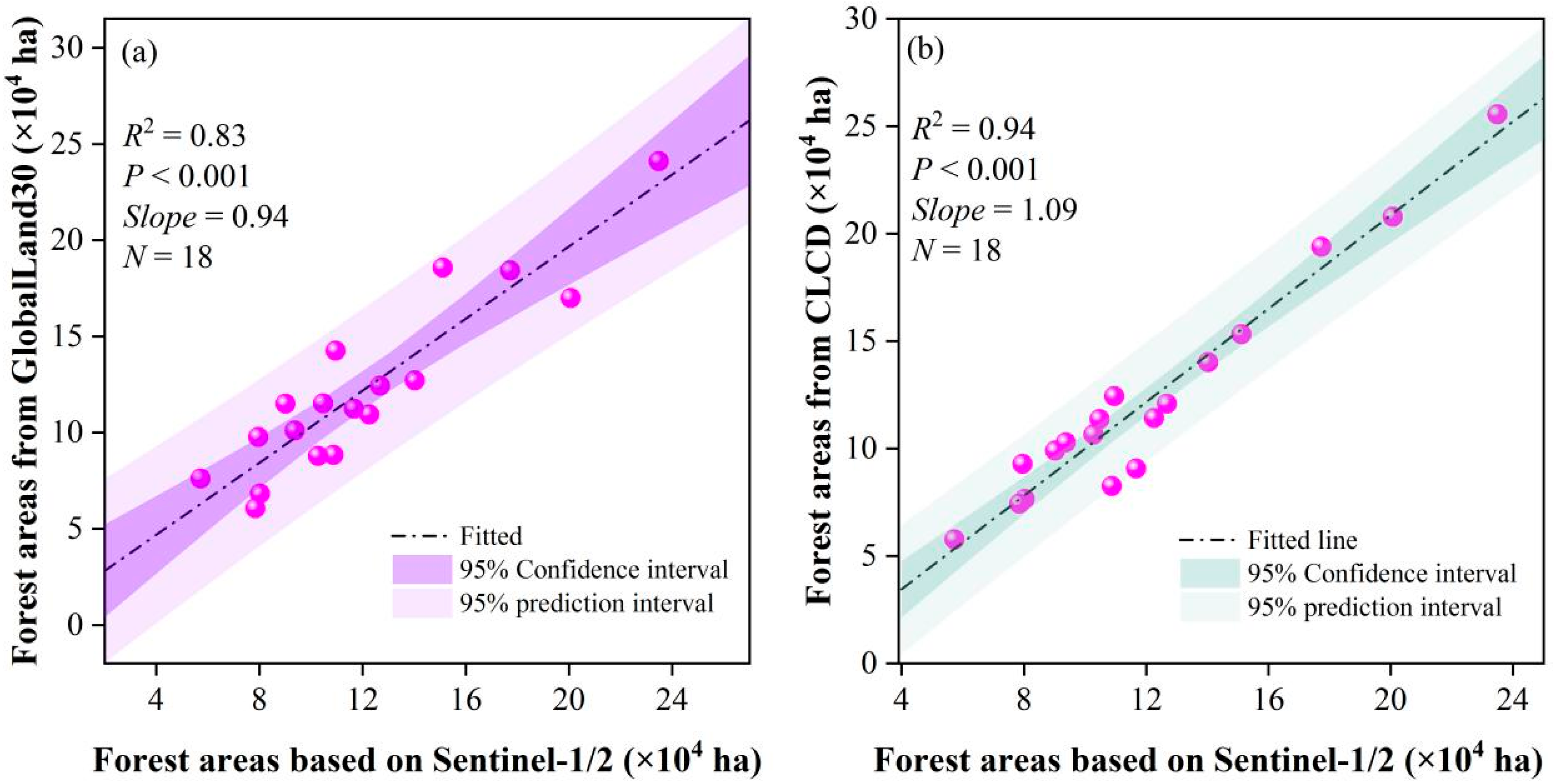
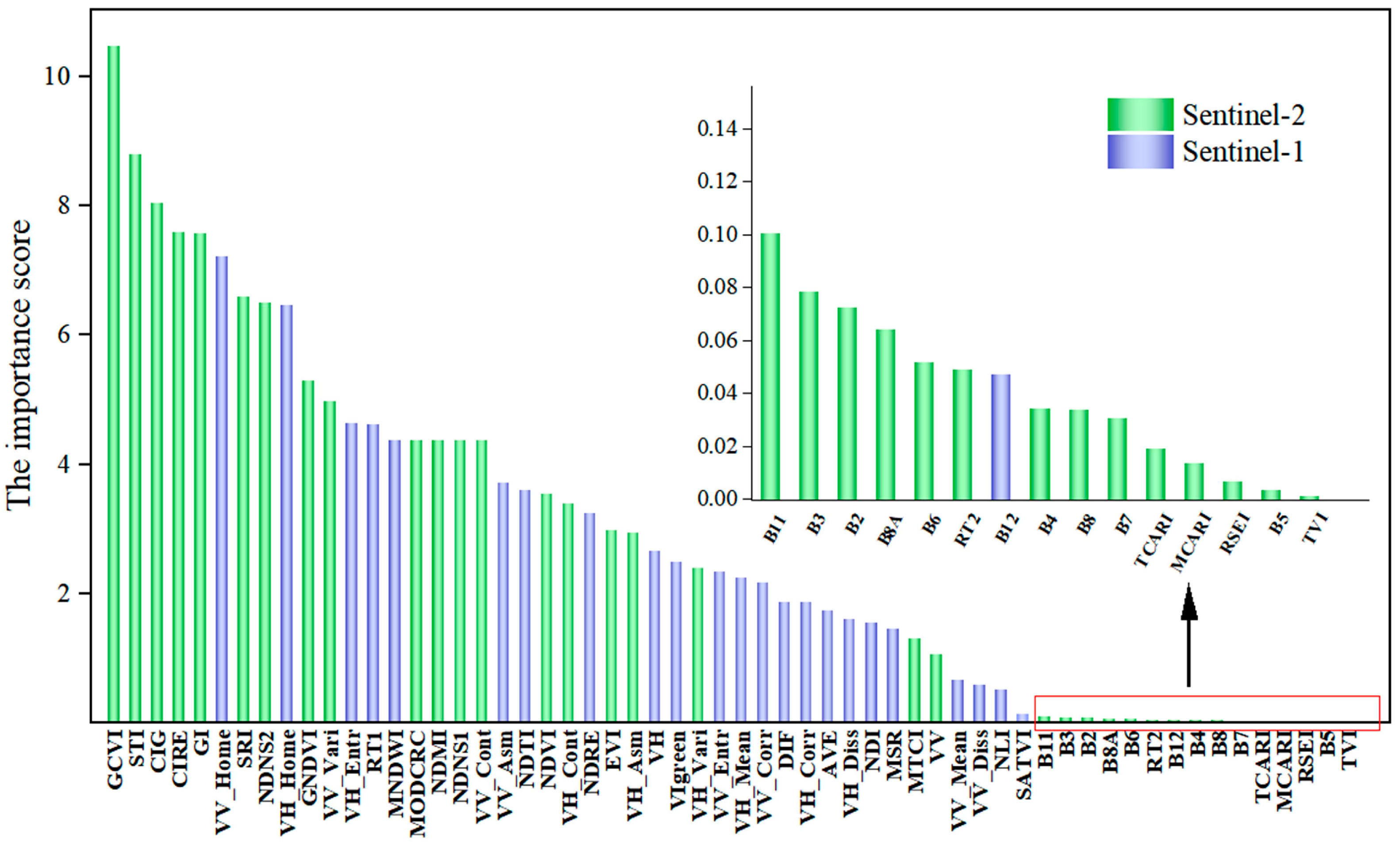


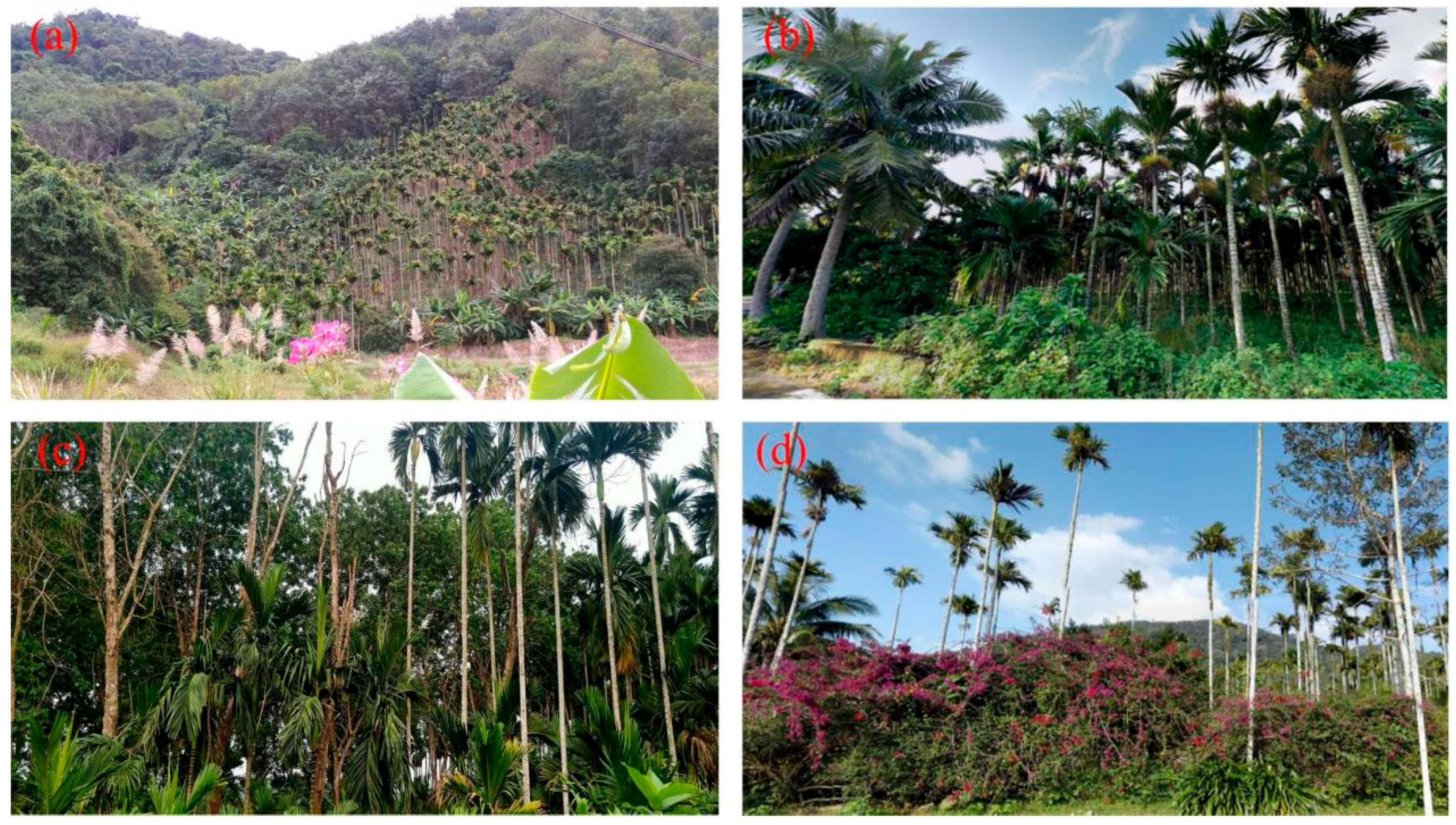

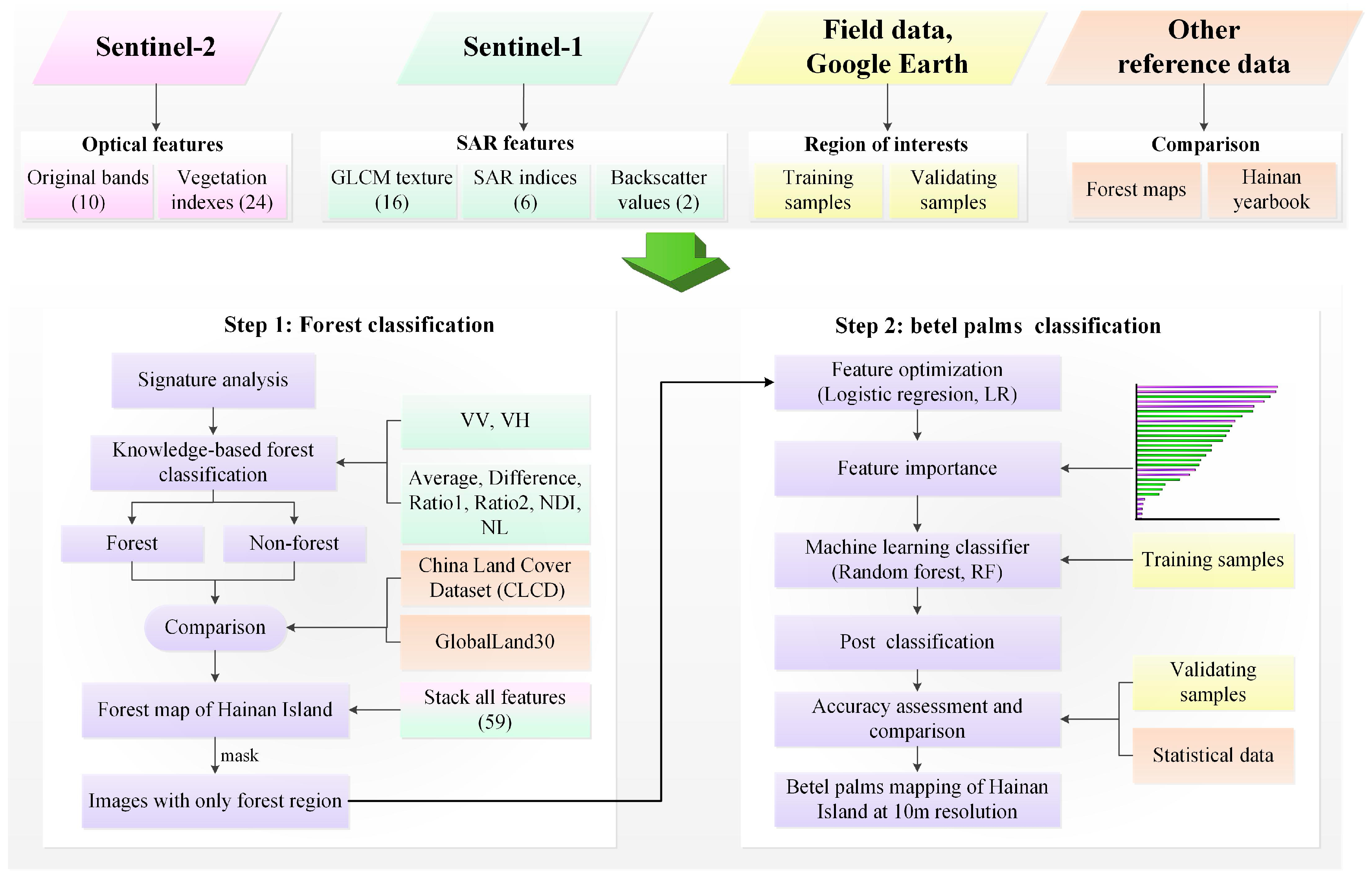
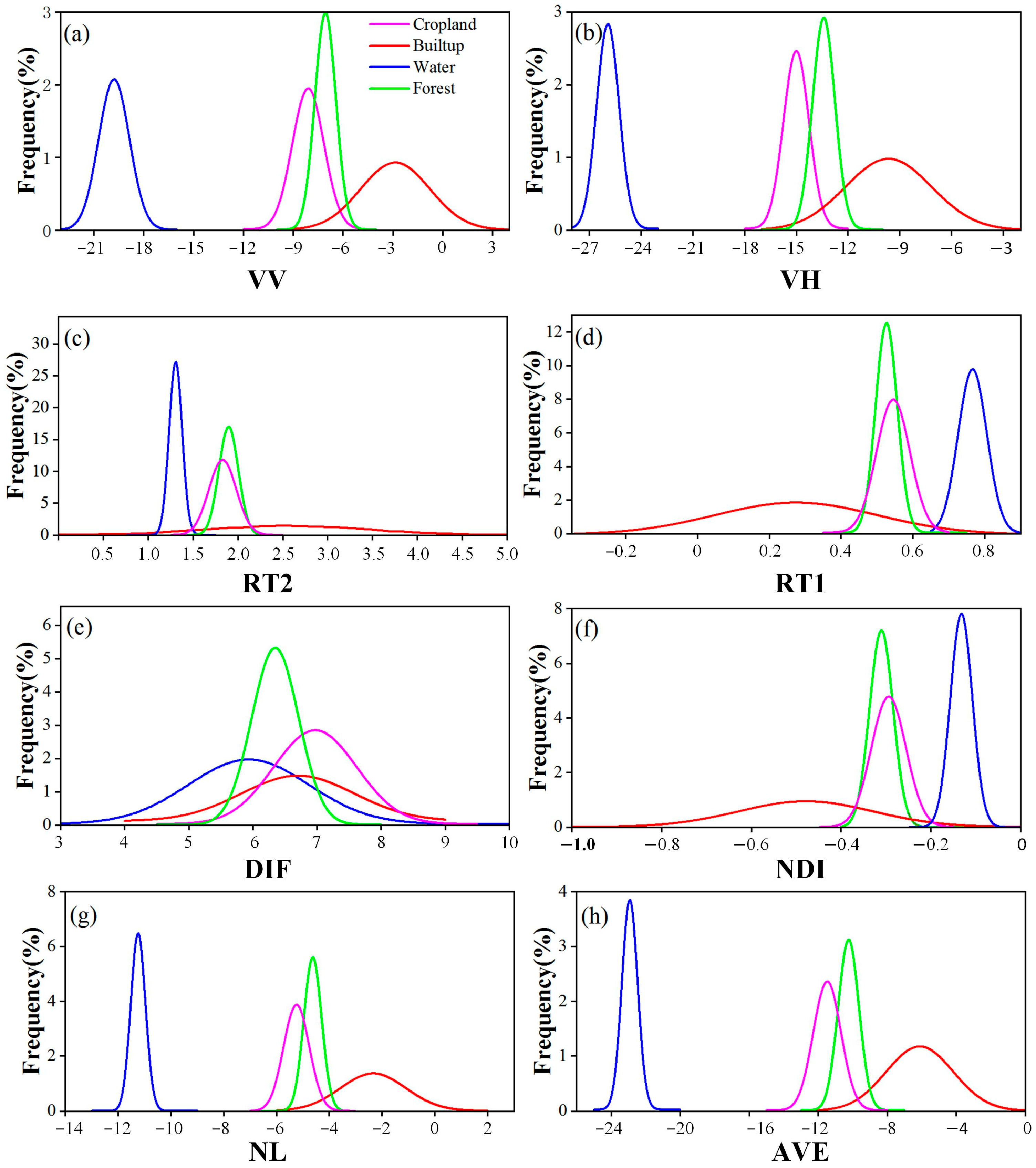

| Total | Betel Palms | Non-Betel Palms | UA | |
|---|---|---|---|---|
| Betel palms | 1763 | 1532 | 231 | 86.89% |
| Non-betel palms | 15,273 | 193 | 15,044 | 98.73% |
| PA | 88.81% | 98.49% | ||
| OA = 97.51% kappa = 0.86 | ||||
| Land Cover and Land Use Types | Description | Number of ROIS | Detail Images in Google Earth |
|---|---|---|---|
| Betel palms | Lower canopy density than that of forests and rubber plantations. Some bare ground can be observed among betel palm rows. | 766 |  |
| Forests | Closed canopy forest with continuous tree cover, with rare anthropogenic disturbance. | 257 |  |
| Rubber plantations | Closed and fairly closed canopy rubber plantations having obvious texture features. | 771 |  |
| Croplands | Paddy fields or dry lands. | 213 |  |
| Built-up areas | Mainly include buildings, roads or residential regions. | 113 |  |
| Water | Mainly include rivers, lakes or reservoirs. | 105 |  |
| Spectral Bands/ Vegetation Index (VI) | Abbreviation | Formula/Spatial Resolution |
|---|---|---|
| vertically polarized backscatter | VV | 10 m |
| cross-polarized, vertical transmitter, horizontal receiver backscatter | VH | 10 m |
| Average | AVE | |
| Difference | DIF | |
| Ratio1 | RAT1 | |
| Ratio2 | RAT2 | |
| Normalized Difference Index | NDI | |
| NL Index | NL | |
| GLCM Homogeneity | VV_Home, VH_Home | |
| GLCM Contrast | VV_Cont, VH_Cont | |
| GLCM Correlation | VV_Corr, VH_Corr | |
| GLCM Mean | VV_Mean, VH_Mean | |
| GLCM Variance | VV_Vari, VH_Vari | |
| GLCM Dissimilarity | VV_Diss, VH_Diss | |
| GLCM Entropy | VH_Entr, VV_Entr | |
| GLCM Angular second moment | VH_Asm, VV_Asm |
| Spectral Bands/Vegetation Index (VI) | Abbreviation | Formula/Spatial Resolution |
|---|---|---|
| Blue | B2 | 10 m |
| Green | B3 | 10 m |
| Red | B4 | 10 m |
| Red Edge1 | B5 | 20 m |
| Red Edge2 | B6 | 20 m |
| Red Edge3 | B7 | 20 m |
| Nir | B8 | 10 m |
| Red Edge4 | B8A | 20 m |
| SWIR1 | B11 | 20 m |
| SWIR2 | B12 | 20 m |
| Enhanced Vegetation Index | EVI | 2.5 × (B8 − B4)/((B8 + 6 × B4 − 7.5 × B2) + 1) |
| Normalized Difference Vegetation Index | NDVI | (B8 − B4)/(B8 + B4) |
| Soil-Adjusted Total Vegetation Index | SATVI | |
| Red-edge Spectral Index | RSEI | (B7 + B6 − B5)/(B5 + B6 + B7) |
| Normalized Difference Tillage Index | NDTI | (B11 − B12)/(B11 + B12) |
| Normalized Difference Moisture Index | NDMI | (B8 − B11)/(B8 + B11) |
| Normalized Difference RE1 | NDRE | (B6 − B5)/(B6 + B5) |
| Green Normalized Difference Vegetation Index | GNDVI | (B8 − B3)/(B8 + B3) |
| Green Chlorophyll Vegetation Index | GCVI | (B8/B3) − 1 |
| Modified Crop Residue Cover | MODCRC | (B11 − B3)/(B11 + B3) |
| Simple Tillage Index | STI | B11/B12 |
| Modified Normalized Difference Water Index | MNDWI | (B3 − B11)/(B3 + B11) |
| Normalized Difference NIR and SWIR1 Index | NDNS1 | (B8 − B11)/(B8 + B11) |
| Normalized Difference NIR and SWIR2 Index | NDNS2 | (B8 − B12)/(B8 + B12) |
| Greenness Index | GI | B3/B4 |
| Green Vegetation Index | VIgreen | (B3 − B4)/(B3 + B4) |
| Simple Ratio Index | SRI | B8/B4 |
| Modified Simple Ratio | MSR | |
| Modified Chlorophyll Absorption in Reflectance Index | MCARI | [(B8 − B4) − 0.2(B8 − B3)] × (B8/B4) |
| Triangular Vegetation Index | TVI | 0.5 × [120 × (B8 − B3) − 200 × (B4 − B3)] |
| Transformed Chlorophyll Absorption in Reflectance Index | TCARI | 3[(B8 − B4)−0.2 (B8 − B3) × (B8/B4)] |
| Medium-resolution Imaging Spectrometer Terrestrial Chlorophyll Index | MTCI | (B6 − B5)/(B5 − B4) |
| Chlorophyll Index Red Edge | CIRE | B7/B5 − 1 |
| Chlorophyll Index Green | CIG | B7/B3 − 1 |
Disclaimer/Publisher’s Note: The statements, opinions and data contained in all publications are solely those of the individual author(s) and contributor(s) and not of MDPI and/or the editor(s). MDPI and/or the editor(s) disclaim responsibility for any injury to people or property resulting from any ideas, methods, instructions or products referred to in the content. |
© 2025 by the authors. Licensee MDPI, Basel, Switzerland. This article is an open access article distributed under the terms and conditions of the Creative Commons Attribution (CC BY) license (https://creativecommons.org/licenses/by/4.0/).
Share and Cite
Luo, H.; Dai, S.; Hu, Y.; Zheng, Q.; Yu, X.; Chen, B.; Li, Y.; Wang, C.; Li, H. Integrating Knowledge-Based and Machine Learning for Betel Palm Mapping on Hainan Island Using Sentinel-1/2 and Google Earth Engine. Plants 2025, 14, 2696. https://doi.org/10.3390/plants14172696
Luo H, Dai S, Hu Y, Zheng Q, Yu X, Chen B, Li Y, Wang C, Li H. Integrating Knowledge-Based and Machine Learning for Betel Palm Mapping on Hainan Island Using Sentinel-1/2 and Google Earth Engine. Plants. 2025; 14(17):2696. https://doi.org/10.3390/plants14172696
Chicago/Turabian StyleLuo, Hongxia, Shengpei Dai, Yingying Hu, Qian Zheng, Xuan Yu, Bangqian Chen, Yuping Li, Chunxiao Wang, and Hailiang Li. 2025. "Integrating Knowledge-Based and Machine Learning for Betel Palm Mapping on Hainan Island Using Sentinel-1/2 and Google Earth Engine" Plants 14, no. 17: 2696. https://doi.org/10.3390/plants14172696
APA StyleLuo, H., Dai, S., Hu, Y., Zheng, Q., Yu, X., Chen, B., Li, Y., Wang, C., & Li, H. (2025). Integrating Knowledge-Based and Machine Learning for Betel Palm Mapping on Hainan Island Using Sentinel-1/2 and Google Earth Engine. Plants, 14(17), 2696. https://doi.org/10.3390/plants14172696







